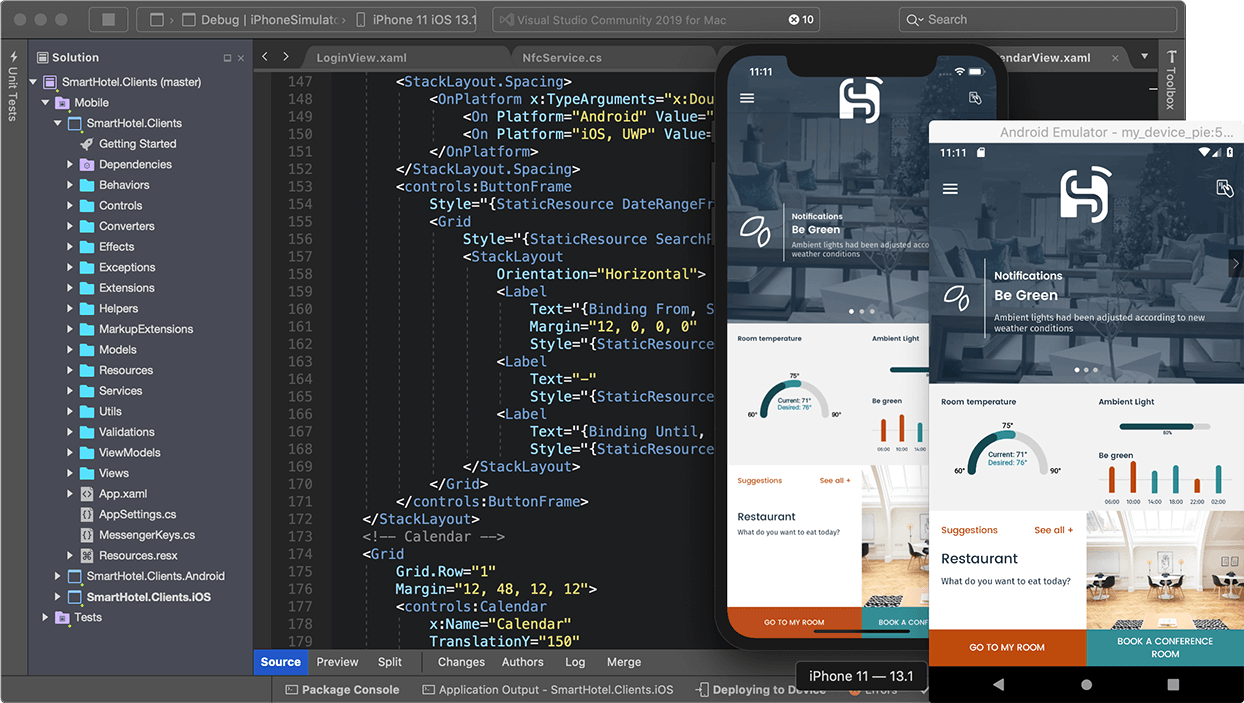- Visual Studio Code Android Emulator
- Visual Studio Emulator For Android Mac Windows
- Visual Studio Android Emulator Network
You can't run Android in a VM so if you are running Windows on a Mac using VMWare Fusion, you'll need to connect to the Android running on the Mac. More detail
- Android Studio is a multi-functional emulator that comes with a good graphical user interface and features. It allows the user to set the emulator window theme as per their choice for a better user experience. It allows users to use multiple applications simultaneously and to take screenshots while using applications in the system.
- Xamarin is a very potent Android emulator, that is somewhat harder to install. It has integration to Visual Studio and is typically used by developers who are looking to find errors in their Android apps. It is definitely a lightweight Android emulator that works both on Windows PC and on Mac OS.
- Visual Studio Emulator How To Choose The. Now, lets recap Visual Studios debugging story for Android and how to choose the VS Emulator for Android. That target can be a device, or it can be one of many emulators that you may have running on your machine. Lets see how to choose a debug target for Cordova, C, and Xamarin in Visual Studio 2015.
- Nov 30, 2020 On Visual Studio 2019 for Mac you can select to install Android and iOS. If you are doing iOS development you will also need to install Xcode on your macOS machine. After this you are all set and ready for mobile development! When you create and run an Android project you may get asked to install additional Android SDKs and create Android emulators. Creating your project. Now that we have Visual Studio 2019 and Xamarin installed let's get to work!
Once you have installed Visual Studio for Mac, open it and run the emulator for Android.

Visual Studio Code Android Emulator
On the Mac
Maxwell embrya download. Open a Terminal on your Mac and enter this to add the Android platform tools into the path:
echo ‘export PATH=$PATH:~/Library/Developer/Xamarin/android-sdk-macosx/platform-tools/' >> ~/.bash_profile
source ~/.bash_profile
adb devices
Visual layout editor. For more information on recommended devices as well as Android emulator support.
If you get a permission error on the bash_profile, run this:

sudo chown YOURACCOUNTNAME ~/.bash_profile

You should see a nice list of the emulators running. That will show you that you have completed the first step. You do not need to ever run this again.
Open TextEdit and add this as a text file:
#!/bin/bash
echo ‘Starting android pipe listener'
cd /tmp
mkfifo backpipe
nc -kl 5555 0 backpipe
In TextEdit go to the Format menu and choose Make Plain Text
In TexEdit save the file to your desktop but without the .txt extension. Note that we unchecked the .txt extension
We now need to tell OSX that the file is an executable. Open Terminal and use the following command and path (yours will be a bit different than mine)
chmod 700 /Users//Desktop/adb
Now we can run it by double clicking the adb file. This should will run in the background always. so many sure it's run when you want to connect to Android from the Windows VM
On the PC
Now that you are running the bash script on the Mac, it's ready to be connected to.
Add a Windows Batch file on your desktop there with the following. Run it one to have the connection set up. It will appear then disappear. If you loose connection, then run it again.
cd C:Program Files (x86)Androidandroid-sdkplatform-tools
adb.exe connect network>
You'll see the Android device in your Visual Studio:
Enjoy!
Problems?
Visual Studio Emulator For Android Mac Windows

Visual Studio Code Android Emulator
On the Mac
Maxwell embrya download. Open a Terminal on your Mac and enter this to add the Android platform tools into the path:
echo ‘export PATH=$PATH:~/Library/Developer/Xamarin/android-sdk-macosx/platform-tools/' >> ~/.bash_profile
source ~/.bash_profile
adb devices
Visual layout editor. For more information on recommended devices as well as Android emulator support.
If you get a permission error on the bash_profile, run this:
sudo chown YOURACCOUNTNAME ~/.bash_profile
You should see a nice list of the emulators running. That will show you that you have completed the first step. You do not need to ever run this again.
Open TextEdit and add this as a text file:
#!/bin/bash
echo ‘Starting android pipe listener'
cd /tmp
mkfifo backpipe
nc -kl 5555 0 backpipe
In TextEdit go to the Format menu and choose Make Plain Text
In TexEdit save the file to your desktop but without the .txt extension. Note that we unchecked the .txt extension
We now need to tell OSX that the file is an executable. Open Terminal and use the following command and path (yours will be a bit different than mine)
chmod 700 /Users//Desktop/adb
Now we can run it by double clicking the adb file. This should will run in the background always. so many sure it's run when you want to connect to Android from the Windows VM
On the PC
Now that you are running the bash script on the Mac, it's ready to be connected to.
Add a Windows Batch file on your desktop there with the following. Run it one to have the connection set up. It will appear then disappear. If you loose connection, then run it again.
cd C:Program Files (x86)Androidandroid-sdkplatform-tools
adb.exe connect network>
You'll see the Android device in your Visual Studio:
Enjoy!
Problems?
Visual Studio Emulator For Android Mac Windows
Visual Studio Android Emulator Network
If when you use the adb devices command on the PC, you get an 'unauthorized' go check the running android and ensure it isn't asking for permission. If it is, grant it then run both script on the Mac and PC to re-establish connection.
